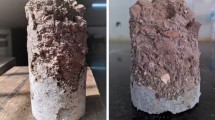Abstract
This paper presents the results of tests for pulse velocity and modulus of elasticity conducted on concrete specimens prepared and cured under both controlled laboratory conditions and natural atmospheric conditions of hot weather. The results have shown that both the pulse velocity and modulus of elasticity of concrete are reduced with increase in concrete mix temperature at preparation, indicating the detrimental effect of hot weather on the quality of concrete. Even if the concrete mix is so designed as to give the required compressive strength for concrete prepared and cured in hot weather, the modulus of elasticity could be reduced by as much as 17.5%.
Résumé
Des problèmes particuliers se présentent quand le bétonnage se pratique par temps chaud. Même s'il est possible de prendre certaines mesures onéreuses pour réduire la température du mélange de béton lors de la préparation, la conservation du béton se fait par temps chaud. L'évaporation rapide de l'eau par temps chaud altère la qualité du béton.
Cet article présente les résultats d'essais sur la vitesse d'impulsion et le module d'élasticité du béton. Les éprouvettes cylindriques ont été préparées et conservées dans des conditions de climat chaud aussi bien en atmosphère naturelle que simulées en laboratoire. La température du mélange du béton lors de la préparation oscillait entre 26 et 45°C.
Les essais de vitesse d'impulsion ont été exécutés en se conformant à la norme ASTM C547. Les résultats de ces essais ont montré que la vitesse d'impulsion du béton préparé et conservé par temps chaud diminue proportion-nellement à l'augmentation de la température du mélange de béton au moment de la préparation. Ceci montre que la qualité du béton est altérée par temps chaud.
On a déterminé le module d'élasticité du béton de deux façons: d'abord en obtenant des valeurs contrainte/ déformation à différents niveaux de charge dans un essai de compression et en calculant le module sécant à la moitié de la résistance à la compression; et ensuite, conformément à la norme ASTM C459. Dans les deux cas, les résultats ont montré que le module d'élasticité du béton préparé et conservé par temps chaud diminue en fonction de l'augmentation de la température du mélange de béton au moment de la préparation. De plus, même si le mélange est calculé aux fins d'obtenir la résistance à la compression requise par temps chaud, le module d'élasticité du béton pourrait diminuer de 17,5% quand la température du mélange atteint 45°C.
Similar content being viewed by others
References
ACI Manual of Concrete Practice, Part 2 (American Concrete Institute, Detroit, Michigan, 1989).
Scanlon, J. M., ‘Quality control during hot and cold weather’,Concr. Int. (September 1979) 58.
Newman, A. J., ‘Problems of Concreting in Arid Climates’, Overseas Building Note 139 (Overseas Division, Building Research Establishment). London, England, August 1971.
Samarai, M., Popovics, S. and Malhotra, V. M., ‘Effect of high temperatures on the properties of fresh concrete’, in Transportation Research Record 924 (Transportation Research Board, Washington, DC 1983), pp. 42–49.
Idem,, ‘Effect of high temperatures on the properties of hardened concrete’, in Transportation Research Record 924 (Transportation Research Board, Washington, DC 1983) pp. 50–55.
‘Design and Control of Concrete Mixtures’, Engineering Bulletin EB001, 11t (Portland Cement Association, Skolie, Illinois, 1979).
Klieger, P., ‘Effect of mixing and curing temperature on concrete strength’,J. Amer. Concr. Inst. 54 (June 1958). 1063.
Neville, A. M., ‘Properties of Concrete’ (Pitman International, London, 1977) p. 213.
Price, W. H., ‘Factors influencing the concrete strength’,J. Amer. Concr. Inst. 47 (Feb. 1951) 417.
Ravina, D. and Shalon, R., ‘The Effect of Elevated Temperature on Strength of Portland Cements’, American Concrete Institute Special Publication Sp-25 (1971) p. 257.
Nasser, K. W. ‘Elevated Temperature Effect on the Structural Properties of Air-Entrained Concrete’, American Concrete Institute Special Publication Sp-39 (1973) p. 135.
Shalon, R. and Ravina, D., ‘Studies in concreting in hot climate’, in RILEM Symposium on Concrete and Reinforced Concrete in Hot Countries, Haifa, July 1960.
ACI Building Code Requirements for Reinforced Concrete, ACI 318-1983 (American Concrete Institute, Detroit, Michigan).
Abbasi, A. F. and Alam, M. S., ‘Compressive strength of concrete in hot weather’,Int. J. Housing Sci. Appli. 6 (2) (1982).
Idem, Abbasi, A. F. ‘Effect of hot weather on bond between steel and concrete’, presented at Symposium on Degradation of Materials in Various Environments, King Abdul Aziz University, Jeddah, Saudi Arabia May 1982.
Abbasi, A. F. and Al-Tayyib, A. J., ‘Effect of hot climate on shear strength of concrete’, in Transportation Research Record 924 (Transportation Research Board, Washington, DC, 1983) pp. 27–32.
Idem,, ‘Effect of hot weather on modulus of rupture and splitting tensile strength of concrete’,Cem. Concr. Res. 15 (1985) 233–244.
Author information
Authors and Affiliations
Rights and permissions
About this article
Cite this article
Abbasi, A.F., Al-Tayyib, A.J. Effect of hot weather on pulse velocity and modulus of elasticity of concrete. Materials and Structures 23, 334–340 (1990). https://doi.org/10.1007/BF02472712
Issue Date:
DOI: https://doi.org/10.1007/BF02472712




